Your houseplants won't clean your indoor air as effectively as you've been led to believe. While the famous 1989 NASA study sparked hope about plants' air-purifying abilities, those results came from controlled lab conditions that don't translate to real homes. You'd need an impractical 680 plants in a typical house to make any meaningful difference. Natural ventilation and air purifiers work far better. Let's explore why this popular belief doesn't hold up to scientific scrutiny.
The NASA Study Myth: Separating Fact From Fiction

While many people still believe houseplants can effectively purify indoor air, the famous 1989 NASA study that sparked this idea doesn't tell the whole story.
The study's findings were based on controlled laboratory conditions that don't reflect real-world environments where you live and work.
Lab experiments rarely mirror real life – what works in a sealed test chamber may fail in your living room.
You might be surprised to learn that the number of plants needed to make any meaningful impact on indoor air pollution would be impractical – somewhere between 10 to 1,000 plants per square meter.
While plants can absorb volatile organic compounds in sealed chambers, they're far less effective in your home.
Natural ventilation actually does a much better job at cleaning your indoor air.
The study's misinterpretation has unfortunately led many people to overlook more effective solutions, like proper ventilation systems and reducing pollutants at their source.
Real-World Plant Performance vs. Laboratory Results
While you might be excited by studies showing plants cleaning air in sealed chambers, the reality in your home is quite different.
You'd need an unrealistic number of plants – between 100 to 1,000 per square meter – to make any meaningful impact on indoor air quality.
Natural ventilation and mechanical systems are far more effective at removing indoor pollutants than houseplants in real-world settings.
Laboratory Conditions Mislead Results
Despite extensive laboratory research suggesting plants can purify indoor air, these controlled experiments paint an unrealistic picture of their real-world effectiveness.
You'll find that laboratory conditions typically isolate single volatile organic compounds in small chambers, while real-world environments contain complex mixtures of pollutants in much larger spaces.
When researchers measure the Clean Air Delivery Rate of plants in actual homes and offices, they discover that plants perform far below expectations set by lab studies.
You'd need an overwhelming number of plants—up to 1,000 per square meter—to match modern ventilation systems.
The famous NASA study, while groundbreaking, created misleading perceptions about plants' air purification capabilities.
Simply opening your windows proves more effective at removing indoor pollutants than filling your space with houseplants.
Natural Settings Show Limits
Real-world studies have shattered the illusions created by laboratory experiments about plants' air-purifying abilities. When you place plants in natural settings with regular air flow, their impact on indoor air pollution becomes negligible. You'd need an impractical number of plants – up to 1,000 per square meter – to make any meaningful difference in reducing volatile organic compounds.
| Setting Type | Air Flow | Plant Effectiveness |
|---|---|---|
| Laboratory | Controlled | High |
| Home/Office | Natural | Low |
| Ventilated Space | Dynamic | Minimal |
Your home's ventilation system or simply opening windows proves far more effective at removing indoor pollutants than houseplants. While plants thrive in sealed test chambers, they can't compete with real-world conditions where air constantly moves and changes. The science is clear: relying on plants alone for air purification isn't a practical solution.
Understanding VOC Absorption Limitations
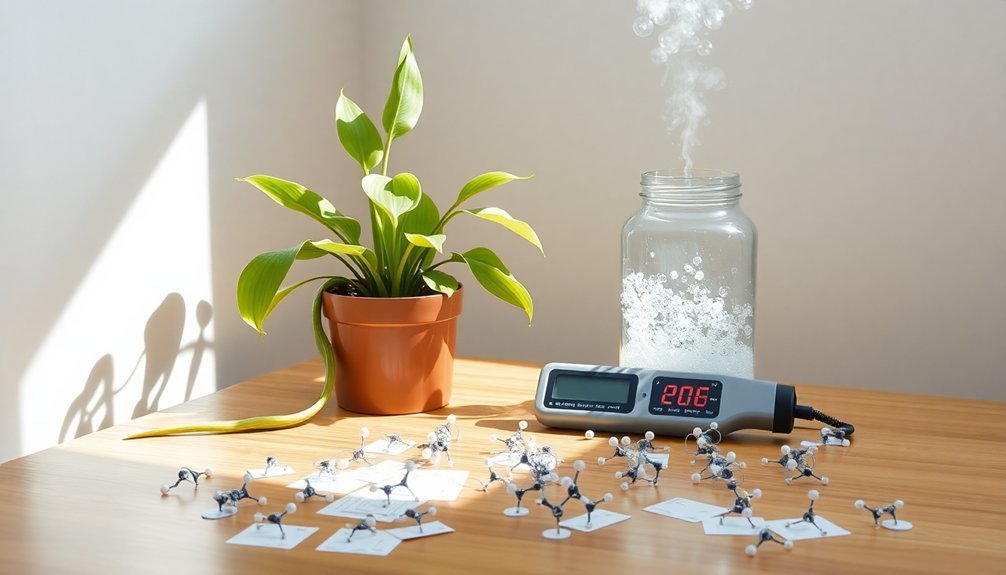
Although many people believe houseplants effectively clean indoor air, scientific research reveals significant limitations in their ability to absorb volatile organic compounds (VOCs).
You'd need an impractical number of plants—between 100 to 1,000 per square meter—to make a meaningful impact on indoor air quality.
While NASA's often-cited 1989 study suggested plants could remove VOCs, those findings came from limited environment testing that doesn't reflect real-world conditions.
In your home, where air naturally circulates, plants' absorption rates are negligible compared to simple ventilation or mechanical air purifiers.
Even in controlled settings, microbes outperform plants at VOC removal.
Opening your windows or using an air handling system will clean your indoor air far more effectively than relying on houseplants alone.
The Numbers Behind Plant-to-Space Ratios
You'll need a substantial number of plants – around 680 for a typical home – to make any meaningful impact on indoor air quality.
When you consider the space requirements, you're looking at 10 to 1,000 plants per square meter to achieve noticeable VOC reductions.
These numbers reveal why mechanical air purifiers are often more practical, as they can clean air more efficiently while taking up far less space than the hundreds of plants needed for similar results.
Required Plants Per Room
Recent scientific findings have shattered the common belief that a few houseplants can greatly purify indoor air. To effectively reduce indoor VOCs, you'd need an astonishing 10 to 1,000 plants per square meter, according to a 2019 meta-analysis.
That means for your home to achieve meaningful pollutant removal, the EPA suggests you'd require about 680 houseplants.
The reality is that your home would need to become a virtual jungle to match the air cleaning capacity of modern ventilation systems. Even if you're willing to pack your rooms with plants, their purification abilities simply can't compete with mechanical air handling systems.
While plants can absorb some VOCs in controlled studies, scaling these benefits to your living space isn't practical or effective.
Space Vs Plant Impact
The stark numbers behind plant-to-space ratios reveal why houseplants can't effectively clean indoor air.
You'd need an overwhelming 10 to 1,000 plants per square meter to make a meaningful impact on your indoor environment – a requirement that's simply impossible for most homes.
When you compare this to standard ventilation systems, the difference is striking.
Research shows you'd have to pack 100 to 1,000 plants into each square meter just to match what basic ventilation can accomplish.
These findings challenge the popular belief that a few potted plants can purify your space.
In fact, natural ventilation removes indoor pollutants far more efficiently than plants can absorb them.
The controlled studies that suggested plants were effective air cleaners used small, sealed chambers – conditions that don't reflect real-world spaces.
Natural Ventilation's Superior Impact
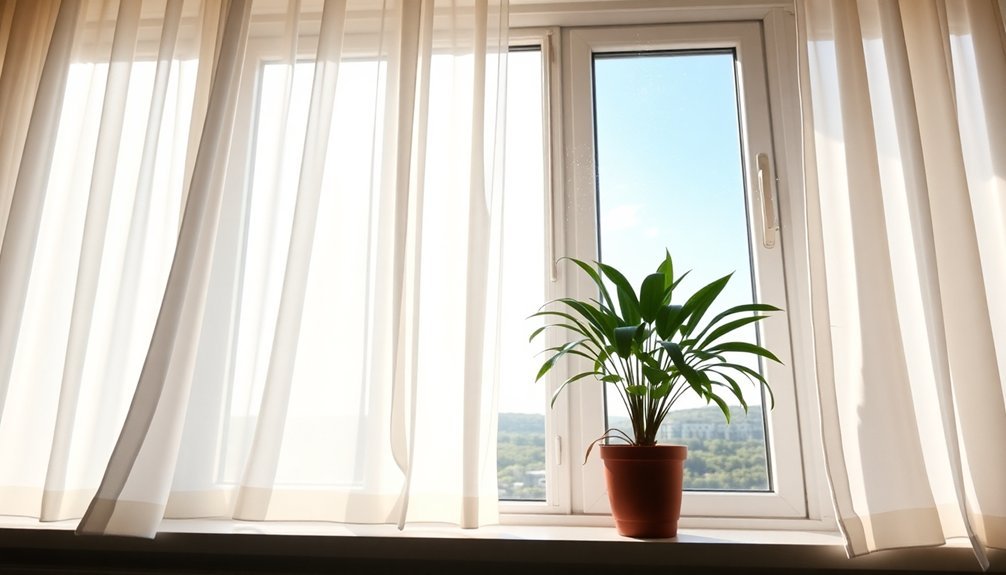
While many people turn to houseplants for improving indoor air quality, natural ventilation proves far more effective at reducing airborne pollutants.
You'll get better results by simply opening your windows or using mechanical ventilation systems, as they dilute volatile organic compounds much faster than plants can absorb them.
Air exchange rates through proper ventilation greatly outperform houseplants in cleaning indoor air.
To match the effectiveness of a standard ventilation system, you'd need an impractical number of plants—between 100 and 1,000 per square meter.
The clean air delivery rate measurements clearly show that modern ventilation systems handle air purification more efficiently than plants, which have minimal impact in real-world settings.
In well-ventilated spaces, you don't need to rely on plants for oxygen production, as fresh air circulation maintains healthy indoor air quality.
Common Houseplant Misconceptions Debunked
Popular beliefs about houseplants' air-purifying abilities have persisted for decades, yet scientific evidence tells a different story.
While you might think your collection of indoor plants considerably improves air quality, research shows you'd need an unrealistic number – 100 to 1,000 plants per square meter – to make a meaningful difference.
These misperceptions often stem from the 1989 NASA study about plants removing volatile organic compounds, but newer research proves natural ventilation works far more effectively for air purification.
You won't greatly boost oxygen levels with houseplants either, as properly ventilated spaces already maintain healthy oxygen concentrations.
What's more, overwatering your plants can actually worsen indoor air quality by promoting mold growth and triggering allergies.
It's time to appreciate plants for their beauty rather than mythical air-cleaning powers.
Measuring Indoor Pollutant Removal Rates
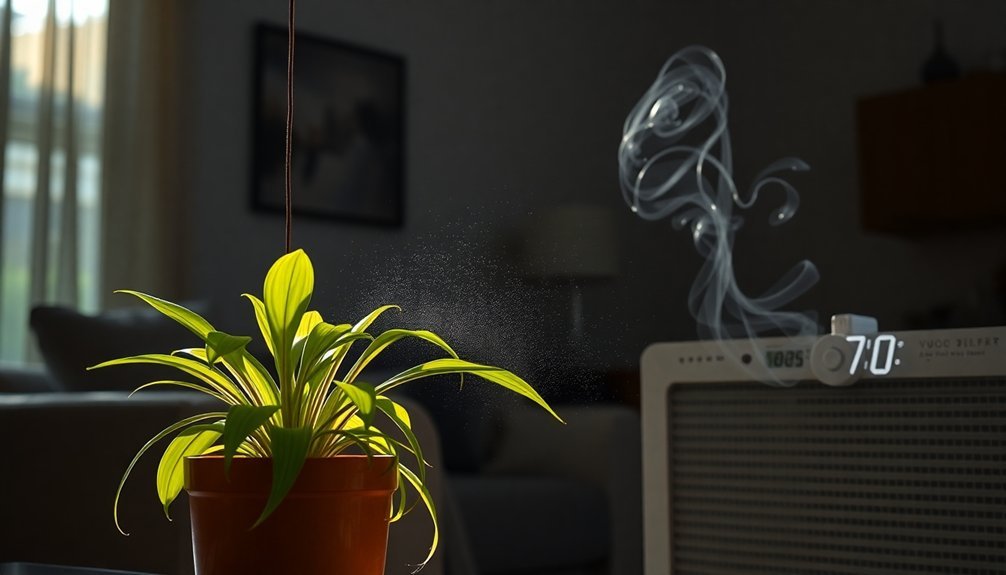
Scientific measurements of indoor pollutant removal rates reveal stark limitations in plants' air-cleaning abilities. You'd need an impractical number of plants – between 100 to 1,000 per square meter – to match the effectiveness of standard air handling systems.
While previous studies in controlled environments suggested promising results, they don't reflect real-world conditions in your home.
Here's what research actually shows about plants and indoor air quality:
- The Clean Air Delivery Rate (CADR) confirms that plants perform poorly compared to mechanical air purifiers.
- Natural ventilation achieves far superior air exchange rates than plants for removing pollutants.
- Soil microbes, not the plants themselves, are primarily responsible for VOC absorption.
These findings demonstrate why you shouldn't rely on plants as your primary strategy for improving indoor air quality.
Soil Microbes vs. Plant Leaves in Air Purification
You might be surprised to learn that soil microbes, not plant leaves, do most of the work in removing indoor air pollutants.
The root systems and their associated microorganisms are particularly effective at breaking down volatile organic compounds (VOCs), while the leaves play a minimal role in air purification.
This finding challenges the common belief that leafy plants clean indoor air primarily through their foliage, when it's actually the microscopic life in the soil that's making the biggest impact.
Microbes Do Heavy Lifting
While many people believe that plant leaves are responsible for purifying indoor air, recent research reveals that soil microbes do most of the heavy lifting.
Studies in controlled environments show that microbes actively break down VOCs, while plants play a minimal role in air purification.
Here's what you need to know about soil microbes and air quality:
- Soil microorganisms are the primary agents responsible for absorbing and breaking down volatile organic compounds.
- The clean air delivery rate of plants is considerably lower than mechanical ventilation systems.
- While your houseplants look beautiful, it's actually the microscopic life in their soil that's cleaning your air.
This research challenges the common misconception that plant leaves are natural air purifiers.
If you're serious about improving indoor air quality, you'll want to contemplate more efficient solutions like proper ventilation systems.
Plant Leaves Less Important
Research has shattered the long-held belief that plant leaves are nature's air purifiers. While you might think your leafy houseplants are cleaning your indoor air, studies reveal that soil microbes, not leaves, do most of the air purification work.
Laboratory tests show that plant leaves have minimal impact on reducing VOCs in indoor environments. You'd need an unrealistic number of plants to make any noticeable difference in your home's air quality.
The Clean Air Delivery Rate of plants is surprisingly low compared to standard air handling systems, proving that leaves aren't the efficient air cleaners we once thought they were. Instead, it's the microscopic organisms living in the soil that effectively break down harmful VOCs.
This discovery challenges traditional views about how plants contribute to cleaner indoor air.
Root Systems Drive Purification
Although leaves were once thought to be the primary air purifiers, recent studies reveal that root systems and their associated soil microbes are the true champions of indoor air cleaning.
The soil-root interaction creates an ideal environment for breaking down volatile organic compounds (VOCs), making air purification more effective than previously believed.
Here's what you need to know about how root systems drive air cleaning:
- Root systems foster healthy microbial communities that actively break down indoor air pollutants.
- Soil microbes are considerably more effective at processing VOCs than plant leaves.
- For meaningful air purification in indoor environments, you'd need 10-1,000 plants per square meter.
This means your focus should shift from leafy plants to creating conditions that support thriving root systems and soil microbe populations for better air quality.
The Science of Indoor Air Exchange
When considering indoor air quality, natural ventilation and mechanical air exchange systems prove far more effective than houseplants alone.
You'll find that typical buildings rely on a combination of infiltration, ventilation, and mechanical systems to maintain healthy air conditions. These systems efficiently dilute volatile organic compounds at rates that plants simply can't match.
Scientific measurements using the Clean Air Delivery Rate demonstrate that mechanical systems outperform plants markedly in real-world settings.
Clean air delivery rate studies definitively show mechanical ventilation systems are superior to plants for purifying indoor air in everyday conditions.
While laboratory studies might suggest plants can purify air, these tests occur in small, controlled chambers that don't reflect your home's actual environment.
To achieve similar results to mechanical ventilation, you'd need an impractical number of plants—somewhere between 100 to 1,000 per square meter.
That's why proper ventilation remains your best strategy for maintaining clean indoor air.
Environmental Factors Affecting Plant Efficiency
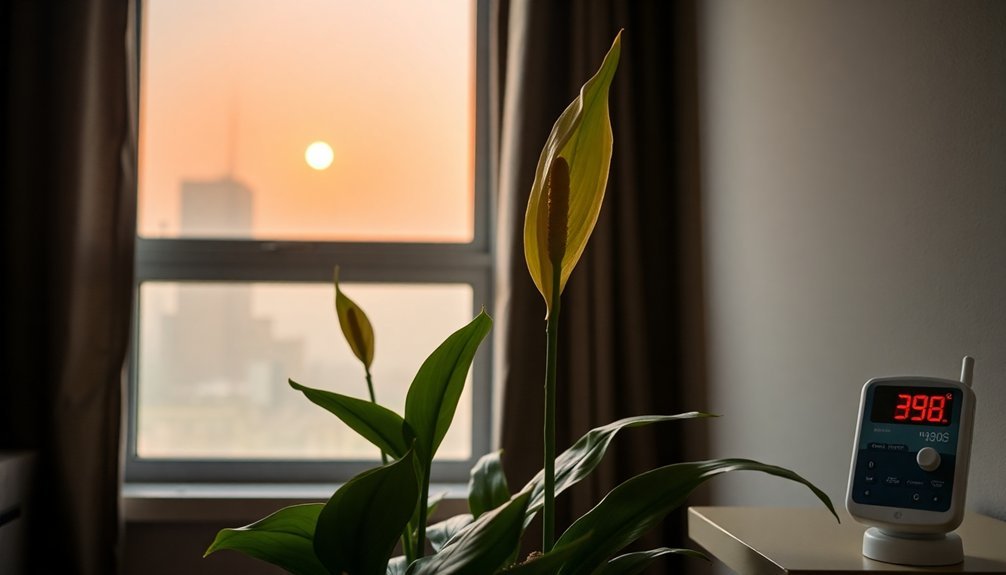
Despite their natural appeal, a plant's ability to clean indoor air depends heavily on several interconnected environmental conditions.
The relationship between environmental factors and plant efficiency in removing indoor air pollutants is more complex than you might think. Natural air exchange through ventilation often works faster than plants can filter volatile organic compounds, greatly reducing their effectiveness.
Here are the key challenges affecting plant performance:
- Plant selection and soil quality directly impact filtration capacity
- Improper maintenance, like overwatering or dusty leaves, can create mold problems
- Multiple VOCs present simultaneously make it harder for plants to filter effectively
You'd need about 680 houseplants in a typical home to make a meaningful difference in air quality, making plants an impractical solution for air purification on their own.
Alternative Methods for Better Air Quality
Since plants alone can't effectively purify indoor air, you'll need to implement more practical solutions to maintain a healthy environment.
Start by focusing on source control – remove products that emit VOCs, like certain paints and cleaning supplies. Next, improve ventilation by opening windows regularly and using exhaust fans to bring in fresh outdoor air.
Installing mechanical air cleaning systems, particularly HEPA air purifiers, will capture nearly all airborne particles and greatly improve your indoor air quality.
Don't forget to maintain your HVAC system by replacing furnace filters every few months, preferably with high-efficiency MERV 13 filters.
Finally, establish a regular cleaning routine to remove dust and allergens from surfaces.
These proven methods will create a considerably healthier indoor environment than relying on plants alone.
Latest Research on Plant Purification Claims
While many people still believe houseplants can substantially purify indoor air, recent scientific evidence suggests otherwise. A thorough 30-year analysis published in the Journal of Exposure Science and Environmental Epidemiology challenges long-held assumptions about plants and indoor air quality.
Key findings reveal that:
- You'd need between 100-1,000 plants per square meter to match the effectiveness of ventilation systems.
- Microbes, not plants, are the primary absorbers of volatile organic compounds (VOCs) in controlled settings.
- Natural ventilation dilutes pollutants more efficiently than plants can remove them.
The research demonstrates that your houseplants aren't the air purification powerhouses they were once thought to be.
Instead of relying on plants for clean air, you'll achieve better results by focusing on proper ventilation and mechanical air cleaning systems.
Frequently Asked Questions
Do Plants Really Clean the Air in Your House?
While your houseplants can absorb some pollutants, they won't meaningfully clean your home's air. You'd need hundreds of plants per square meter, making standard ventilation like opening windows far more effective for air purification.
What Plant Removes 78% of Airborne Mold?
The Peace Lily (Spathiphyllum) can remove up to 78% of airborne mold spores in your home. You'll need to maintain it properly with regular watering and good drainage to maximize its mold-fighting effectiveness.
Is It Healthy to Sleep in a Room With Plants?
Yes, you can safely sleep with plants in your room. They'll create a calming environment and won't greatly affect oxygen levels. Just guarantee proper ventilation, avoid overwatering, and choose low-allergen varieties for maximum benefits.
How Many Plants Does It Take to Purify the Air in a Room?
You'd need an impractical number of plants – between 10 to 1,000 per square meter – to effectively purify your room's air. Opening windows or using ventilation systems will clean your air more efficiently.
In Summary
You've likely heard that houseplants can purify your indoor air, but the science shows they're not the powerhouse cleaners you might think. While plants do absorb some pollutants, you'd need an unrealistic number to make a meaningful difference. Instead, focus on proper ventilation, air filtration systems, and reducing VOC sources to effectively improve your home's air quality. Don't count on your potted friends to do the heavy lifting.

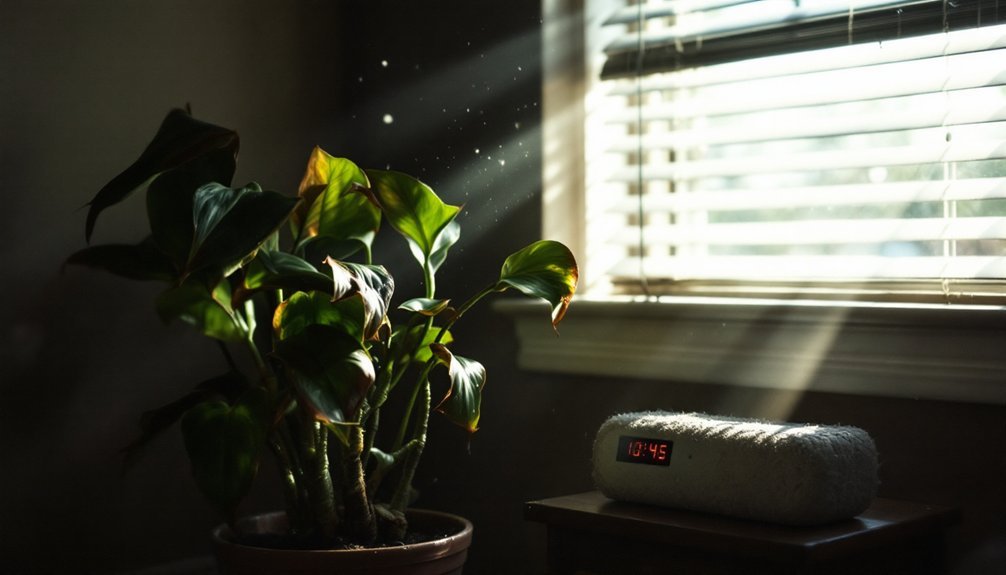



Leave a Reply